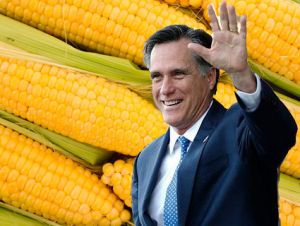Dr. Earl Beaver, who was Monsanto's waste director during the Bain period, says that Bain was certainly "aware" of the "PCB and dioxin scandals" because they created "a negative public perception that was costing the company money." So Bain recommended focusing "on the businesses that didn't have those perceptions," Beaver recalls, starting with "life science products that were biologically based," including genetically engineered crops, as well as Roundup, the hugely profitable weed-killer. "These were the products that Bain gave their go-ahead to," Beaver contends, noting that Romney was a key player, "reviewing the data collected by other people and developing alternatives," talking mostly to "the higher muckety-mucks."In other words, Romney and Bain played crucial roles in shaping Monsanto's strategy of selling off big chunks of its legacy chemical businesses and reinventing itself as ag-biotech firm.
And one of those "higher muckety-mucks," then-Monsanto CEO John W. Hanley, was so impressed with Romney's work that he helped launch Bain Capital, the spin-off private-equity firm to which Romney owes his fortune, explicitly as a vehicle to keep Romney in the Bain fold, Barrett reports. Hanley even placed $1 million of his own cash in Bain Capital's original investment fund.
There's no mystery why Monsanto would want to distance itself from its old business lines. As we know from documents that have dribbled out from legal proceedings over the years, Monsanto had essentially been operating as a corporate criminal. Here's a 2002 Washington Post article on the company's PCB business:
[F]or nearly 40 years, while producing the now-banned industrial coolants known as PCBs at a local factory, Monsanto Co. routinely discharged toxic waste into a west Anniston [Alabama] creek and dumped millions of pounds of PCBs into oozing open-pit landfills. And thousands of pages of Monsanto documents—many emblazoned with warnings such as "CONFIDENTIAL: Read and Destroy"—show that for decades, the corporate giant concealed what it did and what it knew.It's not clear how much Romney knew about these depraved acts in the late 1970s, but as noted above, the strategy he helped cook up was certainly smart, in a reptilian, money-making sort of way: Quietly skitter away from the now toxic (in PR terms) chemical industry, selling old business lines as fast as possible, and invest the proceeds in a new, shiny, positive-sounding field called "biotechnology." And specialize in "feeding the world," which sounds a hell of a lot nicer than dumping carcinogenic gunk in creeks. The strategy was by no means as obvious as it now seems in hindsight: Monsanto was exiting a steady, established business, industrial chemicals, in favor of a highly speculative and new one, ag biotech. But it worked brilliantly—by the time those PCB revelations came out in 2002, Monsanto could plausibly protect its image by saying, that was all in the past; we don't make those kinds of chemicals anymore.
In 1966, Monsanto managers discovered that fish submerged in that creek turned belly-up within 10 seconds, spurting blood and shedding skin as if dunked into boiling water. They told no one. In 1969, they found fish in another creek with 7,500 times the legal PCB levels. They decided "there is little object in going to expensive extremes in limiting discharges." In 1975, a company study found that PCBs caused tumors in rats. They ordered its conclusion changed from "slightly tumorigenic" to "does not appear to be carcinogenic."
Of course, in its new, Bain-ified manifestation, Monsanto 2.0 remained quite ruthless in its pursuit of profit. As Barrett puts it, the metamorphosis merely meant "trading one set of environmental controversies for another."
Source: http://www.motherjones.com/tom-philpott/2012/09/romney-monsanto-bain












No comments:
Post a Comment